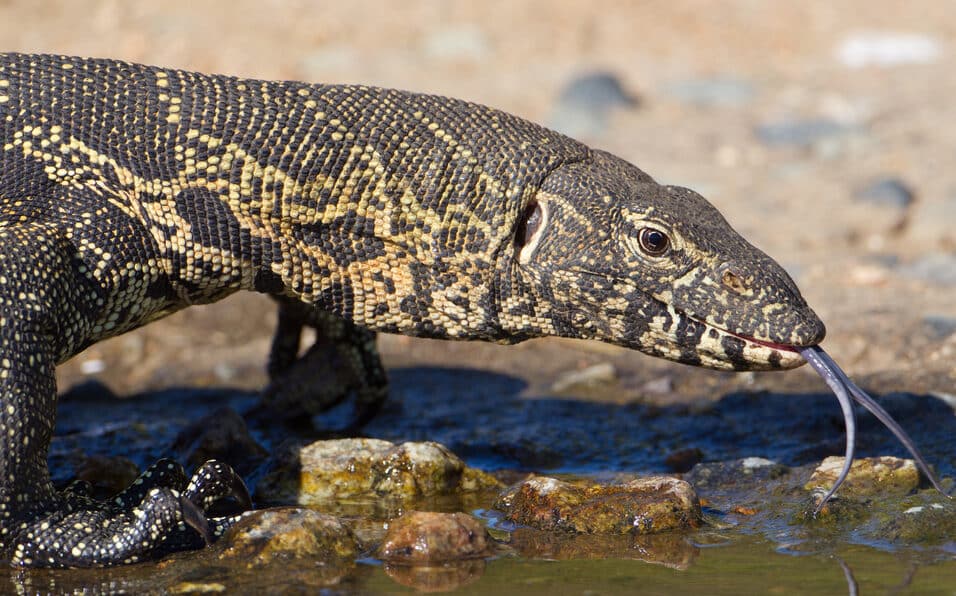5 Common LIZARDS found in Namibia! (ID GUIDE)
Do you want to learn about the different kinds of lizards in Namibia?

If so, you’ve come to the right place! In the article below, I have listed the lizards you can expect to see. For each species, you’ll find out how to identify that lizard correctly, along with pictures and interesting facts!
5 Lizards That Live IN Namibia:
#1. Nile Monitor
- Varanus niloticus

How to identify:
- Length: Between 47 – 86 inches (119 to 218 cm).
- Lifespan: Between 10 and 20 Years.
- Nile Monitors have prominent skin patterns; both males and females are grey/brown on top and have green/yellow barring on their tails. Both sexes have large, greenish-yellow spots on their backs, and their underside and throats are creamy-yellow.
Nile Monitors are one of the largest and most spectacular lizards to observe in Namibia.
Look for them roaming near a permanent water source near woodlands, scrubs, evergreen thickets, mangroves, and swamps. Nile Monitors feed on frogs, toads, rodents, small turtles, birds, eggs, insects, and fish.
Luckily, the Nile Monitor is a lizard, not a human; otherwise, society would frown upon its polygamous behavior. Both males and females mate with several other partners.
After mating, the female takes a break from the males and makes a suitable nest in termite borrows or digs a hole near water where she lays up to 60 eggs. The female is patient during the incubation process, which lasts six to nine months. The baby monitors dig their way to freedom, or the female digs them out, and after three to four years, they are ready to mate themselves.
#2. Flap-necked Chameleon
- Chamaeleo dilepis

How to identify:
- Males and females have a coloring that ranges from brown to yellow to green. Both sexes have between 1 and 3 light patches on their upper flanks and a light stripe on their lower sides.
- It is identified by its broad tail that starts at the base and a spur that grows behind each hind foot.
The Flap-necked Chameleon is a large lizard belonging to the Chamaeleonidae family, a common sight in Namibia. These unique lizards prefer moist or arid savannah, coastal forests, bushy grass, and woodlands, but it is known to venture into suburban and rural areas. They feed on various insects and invertebrates, like beetles and grasshoppers.
When it is time for breeding, the Flap-necked Chameleon male is no stranger to showing off his strength and masculinity by fighting other males to secure a suitable female. Winning the fight does not necessarily persuade the female, but it at least allows the male to approach her.
If the male is accepted, courtship with the female is brief and only lasts a few minutes. Mating lasts about an hour and is done in the trees’ safety.
#3. Wahlberg’s Striped Skink
- Trachylepis wahlbergii
By Ryanvanhuyssteen – Own work, CC BY-SA 4.0
How to identify:
- They are greyish/brown and have a white belly with a thin black band that runs from its shoulder to its eye.
- The male and female look similar, but the male has a yellowish/orange throat during breeding.
The Wahlberg’s Striped Skink is a very active lizard in Namibia, inhabiting woodlands, savannas, suburbs, and semi-dry areas. These medium-sized reptiles are great climbers and prefer to scurry along trees, rocks, and buildings. They are “diurnal,” meaning they are mostly active during the daytime and often basking in the sun on a ledge, log, or rock.
With extraordinary climbing ability and astonishing hunting skills, the Wahlberg’s Striped Skink makes quick work when it attacks its prey. They mostly hunt crickets, flies, grasshoppers, caterpillars, and beetles, but they also feed on earthworms, centipedes, millipedes, slugs, snails, and woodlice. Larger individuals also eat small lizards, rodents, and geckos.
#4. Southern Rock Agama
- Agama atra

How to identify:
- Colors range between brown and grey, but they all have a white belly.
- A pale stripe runs through the center of their tail.
- During the mating season, the adult male’s head turns blue.
Namibia is home to the Southern Rock Agama, an incredibly beautiful and lively lizard. They can be found in rocky landscapes and mountainous regions.
Males are territorial but seldom display aggression toward others and will avoid fighting if possible. But when the male has no choice but to fight, he shows dominance over other males by changing color, charging with his mouth open, and bobbing his head.
Males make females feel like royalty by repeatedly bowing their heads. After the female finds the male worthy, the pair copulate.
#5. Cape Skink
- Trachylepis capensis
Also called the Cape Three-lined Skink.

How to identify:
- A rather fat grey or olive-brown lizard with three pale stripes that run down its back.
- The male and female look similar and have no sexual size dimorphism.
These lizards adapt well to humans in Namibia!
In fact, Cape Skinks can become quite tame if they live near people. Some individuals have even been trained to eat out of one’s hand!
Unfortunately, domestic cats have wreaked havoc on many populations of Cape Skinks. These introduced predators will typically kill all the skinks in their immediate area, as they have no natural defenses for cats.
Look for Cape Skinks at the base of rocks or trees, where they typically dig a small tunnel to hide inside. They will use just about anything as a temporary shelter!
Do you want to learn MORE about animals in Namibia?
Check out these ID Guides!
-
19 Dangerous Predators Found in Namibia
-
17 Types of Antelopes that live in Namibia
-
8 Common SPIDERS Found in Namibia! (w/Pics)
-
13 Common SNAKES That Live in Namibia! (ID Guide)
-
VENOMOUS SNAKES that live in Namibia
Which of these lizards in Namibia is your favorite?
Leave a comment below!


